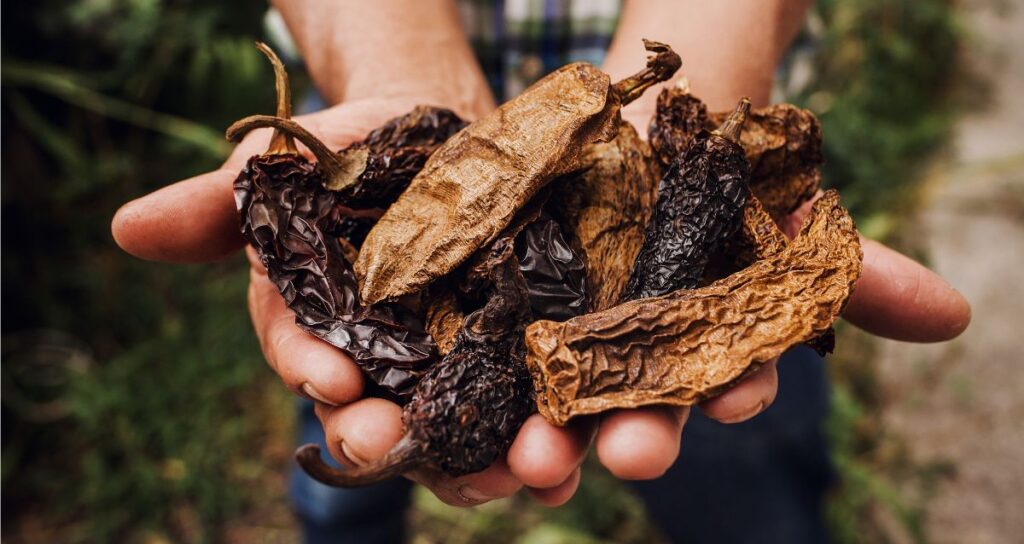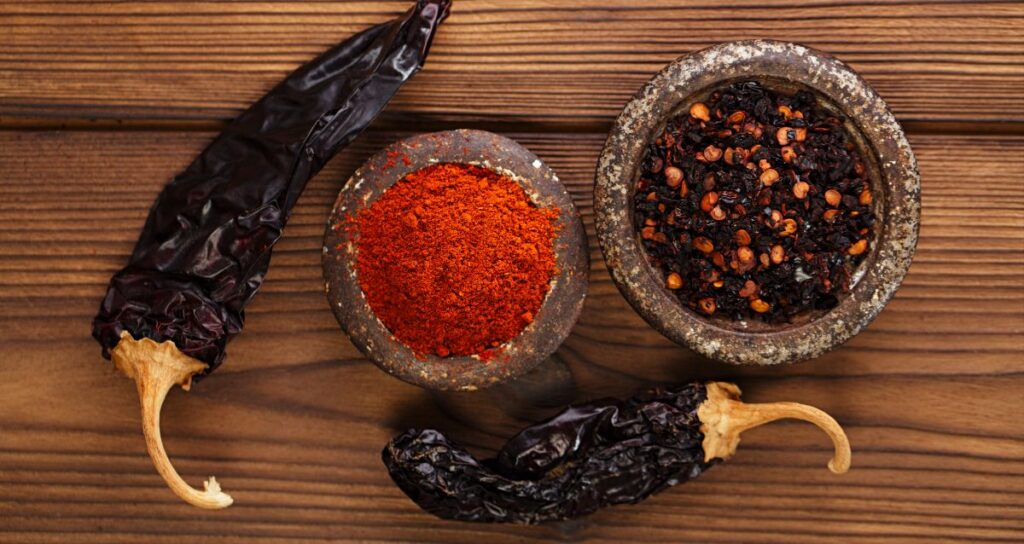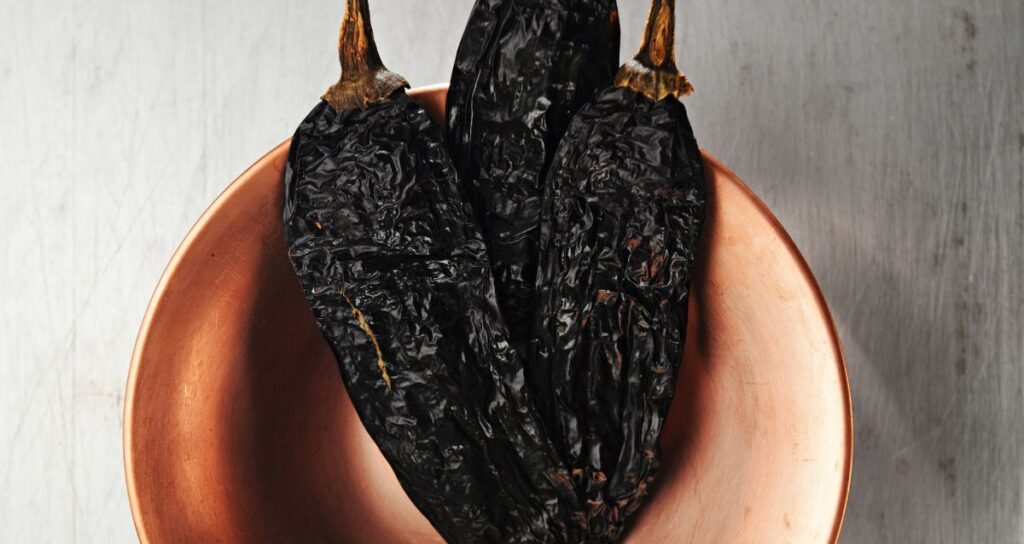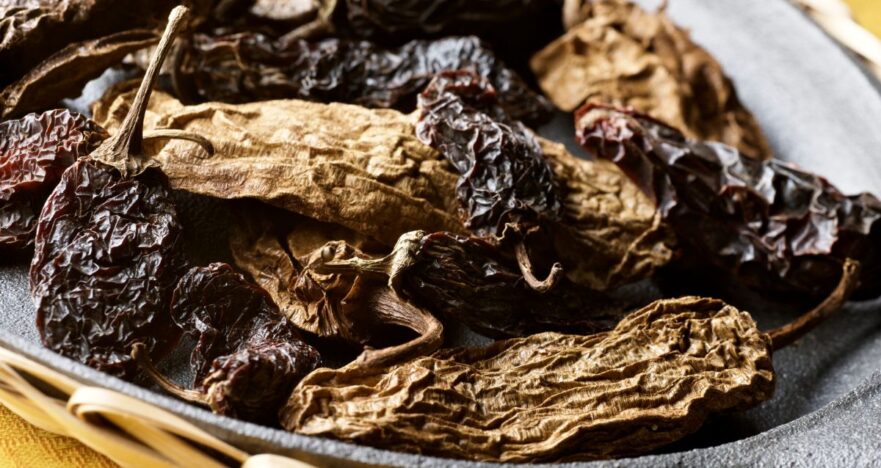In this article about Chipotle pepper:
🗺️ Origin and history | 🌶️ Uses | ✨ Appearance and taste | 🧑🌾 Growing – gardening | 👨🍳 Cooking – recipes | 🛒 Where to buy | 🫙 How to store | 👨⚕️ Health benefits | 🌶️ Alternatives and substitutes | ❓ Frequently asked questions
What is a Chipotle pepper?
In many modern recipes, adding a little heat is an easy way to transform a dish – and this is something that becomes incredibly simple with the right ingredients. One such option is to add chili peppers, which can offer an excellent and reliable way to round out an otherwise bland dish.
Chipotle is just one variety that you may want to consider. As a smoked and dried jalapeño, it originally comes from Mexico and has a distinct wrinkled texture and red-brown coloring due to the drying and smoking process.
These unique peppers are well known for their iconic smoky, earthy flavor. This makes them integral in many salsa, sauce, and stew recipes, to name a few. Most often, they’re available as either whole peppers or in a powder; however, it’s also possible to get them in adobo sauce.
| Chipotle pepper | |
| SHU | 2,500 - 8,000 |
| Median SHU | 5,250 |
| Flavor | Smoky and earthy, with a moderate heat |
| Species | Capsicum annuum (dried, smoked jalapeño pepper) |
| Origin | Mexico |
| Uses | Salsas, chili, soups, stews, marinades, etc. |
Are chipotle peppers spicy? How hot are they?
Chipotle pepper scoville: 2,500 to 8,000 SHU
The Chipotle pepper heat level can range anywhere between 2,500 to 8,000 Scoville, making them much more potent than mild varieties (e.g., pepperoncini or guajillo peppers).
However, while Chipotles are pretty strong, they’re far from extreme in terms of heat. Indeed, there are plenty of other types on the market that can pack more of a punch if such is needed, such as Serrano peppers. These are around four times the strength of Chipotles, based on Scoville. Meanwhile, Habanero peppers can deliver a whopping 100,000 to 350,000 Scoville units.
🗺️ ORIGIN AND HISTORY
Where do Chipotle peppers come from?
Despite being processed before use, Chipotle peppers aren’t a new innovation. In fact, evidence suggests that the smoke-drying technique used for jalapeños dates as far back as Mesoamerican times, even predating the Aztec civilization.
As such, it is highly likely that Christopher Columbus and his explorers would have encountered these smoked chilis during their exploration of the New World. Subsequently, they brought these back to Spain (along with many other discoveries), and this would result in these brilliant ingredients spreading like wildfire across Europe, India, and beyond. These days, Chipotle peppers are a beloved ingredient in various cuisines worldwide, known for their unique smoky flavor and moderate heat level.
One key feature of these peppers is their self-preserving nature, which helped enable their journey across oceans during medieval times – long before travelers had refrigeration and preservation techniques.
🌶️ USES
What are Chipotle peppers good for, and how can they be used?
When it comes to peppers, you want an ingredient that offers excellent versatility. Luckily, this is where Chipotle peppers come in, offering a smoky, earthy flavor that can complement a wide range of dishes. The numerous forms in which they can be found help make them even more adaptable for various culinary creations.
One of the most widely used varieties is hot sauce. This handy ingredient is incredibly popular to help add a smoky kick to meals. Tacos, burritos, and grilled meats are all common examples.
Another alternative is canned Chipotle peppers. Often, you might find these packaged in adobo sauce, further enhancing your dishes’ flavor without the hassles. Common uses include stews, chili, and sauces/salsas.
These excellent ingredients are also available dried, which can then be rehydrated and added to soups or sauces for subsequent use. This form is much easier to store, helping preserve their freshness. However, rehydrating them may not be entirely necessary, as some people choose to crush them for use as a seasoning instead. If you’re making spice rubs, the grounds add plenty of smoky heat that pairs well with grilled or roasted meats. You can also sprinkle it into soups, stews, or chili for an extra layer of flavor.
Finally, they can even be used in a similar manner to red pepper flakes. This is most often seen in pasta and pizza dishes, or you could even add a bit of a kick by sprinkling them over avocado toast – perfect for adding a bit of heat on the fly.

✨ APPEARANCE AND TASTE
What do chipotle peppers look like?
Chipotle peppers are, at their simplest, a smoked, dried form of jalapeño. Thus, their distinctive red-brown and wrinkled appearance comes as a result of the smoking process.
Most often, these peppers are around two to four inches in length while measuring approximately an inch in width. Notably, the whole pepper has a slightly tapered shape, further helping it stand out. However, when ground or crushed into flakes, their deep coloring comes through even more clearly, helping add visual appeal to dishes in addition to their distinct flavor.
What does a Chipotle pepper taste like?
What do chipotle peppers taste like?
Generally speaking, their flavor is characterized by a unique blend of smokiness, earthiness, and a strong spice touch. This distinctive profile comes from letting jalapeños fully ripen and redden and then smoking the peppers over wood to dry and develop their signature taste. Chipotle brings a warm, rich, and slightly spicy flavor to dishes. This often complements a wide array of ingredients and elevates the overall taste experience.
🧑🌾 GROWING – GARDENING
How to grow chipotle peppers?
Originally, Chipotles were found in Mexico; however, it is also possible to cultivate these peppers in a garden environment in many cultures around the world. Their adaptability to a variety of climates makes them a popular choice for relatively new growers, too. With that being said, though, they do tend to thrive best in warm temperatures. Ensure that the peppers also receive plenty of sunlight; the optimal location is one that receives at least six hours of direct sunlight daily.
When growing the plants, ensure they are planted in well-draining soil and watered consistently. It’s also vital to avoid overwatering, as this can lead to root rot and other issues.
In order to get the most from your homegrown peppers, it may be worthwhile to fertilize jalapeños regularly, especially during the growing season. This simple change can help promote strong growth and abundant fruit production.
When to pick jalapeños for chipotle peppers?
There’s no way to say for certain how long it will take to grow Chipotles. But, on average, this will usually be between 70 and 80 days. The jalapeños should have reddened fully before harvesting them to ensure they have a chance to develop their flavor. Once harvested, they can be smoked and dried to create chipotle peppers.

👨🍳 COOKING – RECIPES
Cooking / Recipe ideas for chipotle pepper
If you’re looking for a way to spice up your recipes, adding a little spice could be a great option to consider. Fortunately, these brilliant ingredients are hugely versatile, and their profile allows them to enhance numerous different dishes.
One of the most common ways that you can use these excellent ingredients in your cooking is to try an adobo sauce. Their tangy nature is enhanced by blending them with a rich combination of tomato sauce, vinegar, garlic, sugar, and spices, thereby contributing a delicious depth of flavor.
However, that’s far from the only option. Another way to incorporate chipotle peppers into your cooking is by making a puree. Simply combine rehydrated or canned peppers with a little water or broth, then blitz until smooth in consistency. The resulting puree is often used as a marinade, but it can also make an excellent base for sauces or even serve as a flavor enhancer. One example is to marinate chicken breasts/thighs for several hours in the puree with lime juice, garlic, and spices. Then, the meat can be cooked as preferred (grilled or baked) until cooked through.
As an additional option, simple dishes can also enjoy a quick boost in flavor by adding ground chipotle or flakes. Chili, tacos, and roasted vegetables can all benefit from this quick taste hack!
🛒 WHERE TO BUY
Where can I buy Chipotle pepper?
Generally speaking, Chipotles can be found in the majority of grocery stores. For example, the spice aisle will often provide a selection of dried, ground, or flaked Chipotle ingredients. Alternatively, a quick trip down the International or Mexican food aisles will often yield canned chipotle peppers in adobo sauce.
Of course, smaller stores may have a more limited range; in this case, you could try checking specialty food stores or ethnic markets for a wider selection instead. And, of course, there’s always the option to buy them online, delivered directly to your door.
But remember – not all peppers will necessarily be created equal. As such, make sure to check the packaging for quality and freshness. Ideally, dried peppers should be pliable and have a rich, smoky aroma. Meanwhile, when buying canned options, look for a product that’s in good condition, without signs of bulging or damage to the can. Finally, ground and flaked options should be vibrant in color, maintaining their usual scent.

🫙 HOW TO STORE
How do I store chipotle pepper?
Dried Chipotle peppers can stay in a cool and dark place (e.g., a pantry or cupboard), away from any direct sunlight, moisture, or heat. Simply place the peppers in an airtight container or resealable plastic bag to help maintain their original freshness and prevent them from absorbing any moisture from the air. This should allow them to last for up to a year. Meanwhile, ground or flaked ingredients should be stored in a cool, dark place in airtight containers or spice jars.
But what about cans after opening them? Well, in these cases, simply transfer the contents to an airtight container and refrigerate, where they should last for up to a month.
❤️🩹 HEALTH BENEFITS
Are Chipotle peppers healthy?
Did you know that, alongside being incredibly flavorful, Chipotles can also provide various potential health benefits? They are low in calories and high in fiber, making them potentially healthier as a flavoring option compared to some alternatives. Moreover, they are also rich in vitamin A, which contributes to healthy eyes and skin. These peppers may also contain a range of B vitamins.
In addition to their nutritional features, adding Chipotle to your recipes may have some additional health benefits. For example, capsaicin, the compound responsible for Chipotle’s spiciness, is known to provide anti-inflammatory and pain-relieving properties. This ingredient may also boost metabolism, thereby aiding in weight loss; however, more research is necessary in this regard.
With that being said, it’s worth noting that spicy foods can sometimes cause individuals to suffer stomach discomfort. As such, if you experience any distress after eating Chipotles, it’s best to reduce your intake or avoid them altogether.
🔄 ALTERNATIVES AND SUBSTITUTES
What’s a good chipotle pepper alternative?
Sometimes, Chipotles might not be quite what you’re looking for or may be unavailable at your local stores. Fortunately, depending on your preferences, there are several options that could help with your own recipes.
Ancho peppers, which are dried poblano peppers, can be an excellent alternative. They have a similar smoky flavor and are mildly spicy, making them suitable for a wide range of recipes.
For a slightly hotter option, consider using guajillo peppers. These dried chili peppers have a smoky and earthy taste similar to chipotle peppers, but they pack a bit more heat than Ancho peppers. They can be used in sauces, soups, and stews as a flavorful alternative.
Another possibility is smoked paprika, which provides a similar smoky flavor to chipotle peppers but without the heat. This spice is made from dried, smoked red bell peppers and can be used in various recipes, including rubs, marinades, and sauces.
If you’re looking for a substitute that has both the smoky flavor and the spiciness of chipotle peppers, consider combining cayenne pepper with smoked paprika. This blend will provide the heat and smokiness you’re after in your dish.
How do you pronounce Chipotle?
Chipotle is pronounced as chi-poht-lay.
🙋 FREQUENTLY ASKED QUESTIONS
FAQ about chipotle peppers
Are Chipotle peppers hot?
Generally speaking, Chipotle peppers are considered moderately hot. They have a Scoville rating of 2,500 and 8,000 units, similar to jalapeños. Their smoky, earthy flavor profile contributes to their unique taste, which some might even consider being slightly hotter than jalapeños in certain dishes.
Are Chipotle peppers dried jalapeños?
Yes, Chipotles are, at their simplest, a dried and smoked variety of jalapeño. This process imparts a distinct smoky flavor to the peppers, contributing to their popularity in various Mexican and Southwestern dishes.
Are Chipotle peppers hotter than jalapeños?
Chipotle peppers, being dried and smoked jalapeños, tend to provide a similar level of heat to fresh jalapeños. Generally, they’ll range anywhere between 2,500 and 8,000 Scoville. With that being said, depending on the recipe, Chipotle’s unique smoky flavor has the potential to create a perception of increased heat in certain dishes for some individuals. Growing conditions can also impact the final heat perception.
Are Chipotle peppers in adobo sauce gluten-free?
There’s no way to guarantee that Chipotle peppers in adobo sauce are gluten-free, as this will depend on the brand’s recipe and the specific ingredients used. For example, in some cases, brands use wheat flour as a thickening agent containing gluten. However, other examples may not have gluten in them. In line with this, always check the product‘s label for allergen information; alternatively, look for a gluten-free certification label to ensure the product is suitable for consumption by individuals who might be sensitive to gluten.
Can Chipotle peppers in adobo sauce be frozen?
If you aren’t able to use all of your Chipotle peppers in adobo sauce quickly, they can be frozen. In order to do so, first transfer the peppers and sauce into an airtight container or freezer-safe plastic bag. Make sure to allow some room for expansion. From there, you can store the peppers and sauce in the freezer for up to six months. When ready to use, simply thaw the peppers in the refrigerator overnight. Alternatively, if your microwave has a defrost setting, you may be able to use this for a quick thaw. Always follow the storage instructions on your product’s packaging for further information and guidance.

